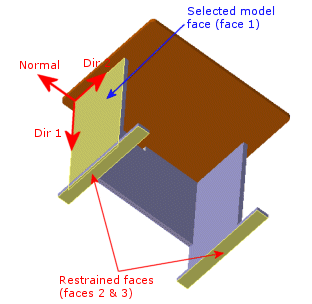You can use a planar model face as a reference to apply restraints. You can prescribe the translations in directions 1 and 2 of the face as well as in the direction normal to the face. For shell meshes, you can prescribe rotations in reference to these directions.
The following table summarizes the attributes of this restraint type:
| Attribute
|
Value
|
|---|
| Possible DOFs for solids
|
3 translations
|
| Possible DOFs for shells and beams
|
3 translations and 3 rotations
|
| Possible DOFs for trusses
|
3 translations
|
| 3D symbol
|
 |
 |
| translation
|
rotation
|
|
| Selectable entities
|
Vertices, edges, faces and beam joints
|
| Translations
|
 Along face direction 1 Along face direction 1
 Along face direction 2 Along face direction 2
 Normal to face Normal to face
|
| Rotations (for shells and beams only)
|
 About face direction 1 About face direction 1
 About face direction 2 About face direction 2
 About normal to face About normal to face
|
Example
 |
 |
| The bottom faces of the legs of desk can only move in their plane (floor).
|
You can use model face 1 as a reference to set the motion of faces 2 & 3 along face direction 1 (Dir 1) to zero. The other two directions (Dir 2 and Normal) should be left unspecified.
|
An easier way is to use the On flat face type and set the normal translation to zero.